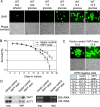Chronological aging leads to apoptosis in yeast
- PMID: 14970189
- PMCID: PMC2171996
- DOI: 10.1083/jcb.200310014
Chronological aging leads to apoptosis in yeast
Abstract
During the past years, yeast has been successfully established as a model to study mechanisms of apoptotic regulation. However, the beneficial effects of such a cell suicide program for a unicellular organism remained obscure. Here, we demonstrate that chronologically aged yeast cultures die exhibiting typical markers of apoptosis, accumulate oxygen radicals, and show caspase activation. Age-induced cell death is strongly delayed by overexpressing YAP1, a key transcriptional regulator in oxygen stress response. Disruption of apoptosis through deletion of yeast caspase YCA1 initially results in better survival of aged cultures. However, surviving cells lose the ability of regrowth, indicating that predamaged cells accumulate in the absence of apoptotic cell removal. Moreover, wild-type cells outlast yca1 disruptants in direct competition assays during long-term aging. We suggest that apoptosis in yeast confers a selective advantage for this unicellular organism, and demonstrate that old yeast cells release substances into the medium that stimulate survival of the clone.
Copyright The Rockefeller University Press
Figures




Similar articles
-
Arsenic induces caspase- and mitochondria-mediated apoptosis in Saccharomyces cerevisiae.FEMS Yeast Res. 2007 Sep;7(6):860-5. doi: 10.1111/j.1567-1364.2007.00274.x. Epub 2007 Jul 12. FEMS Yeast Res. 2007. PMID: 17627776
-
Hyperosmotic stress induces metacaspase- and mitochondria-dependent apoptosis in Saccharomyces cerevisiae.Mol Microbiol. 2005 Nov;58(3):824-34. doi: 10.1111/j.1365-2958.2005.04868.x. Mol Microbiol. 2005. PMID: 16238630
-
Bre1p-mediated histone H2B ubiquitylation regulates apoptosis in Saccharomyces cerevisiae.J Cell Sci. 2010 Jun 1;123(Pt 11):1931-9. doi: 10.1242/jcs.065938. Epub 2010 May 11. J Cell Sci. 2010. PMID: 20460436
-
Apoptosis in yeast: a new model system with applications in cell biology and medicine.Curr Genet. 2002 Jul;41(4):208-16. doi: 10.1007/s00294-002-0310-2. Epub 2002 Jul 5. Curr Genet. 2002. PMID: 12172961 Review.
-
Yeast apoptosis--from genes to pathways.Semin Cancer Biol. 2007 Apr;17(2):112-21. doi: 10.1016/j.semcancer.2006.11.006. Epub 2006 Dec 15. Semin Cancer Biol. 2007. PMID: 17207637 Review.
Cited by
-
Ammonium is toxic for aging yeast cells, inducing death and shortening of the chronological lifespan.PLoS One. 2012;7(5):e37090. doi: 10.1371/journal.pone.0037090. Epub 2012 May 15. PLoS One. 2012. PMID: 22615903 Free PMC article.
-
Bud selection and apoptosis-like degradation of nuclei in yeast heterokaryons: a KAR1 effect.Mol Genet Genomics. 2005 Nov;274(4):419-27. doi: 10.1007/s00438-005-0036-1. Epub 2005 Sep 14. Mol Genet Genomics. 2005. PMID: 16160851
-
Characterization of DNA damage in yeast apoptosis induced by hydrogen peroxide, acetic acid, and hyperosmotic shock.Mol Biol Cell. 2006 Oct;17(10):4584-91. doi: 10.1091/mbc.e06-05-0475. Epub 2006 Aug 9. Mol Biol Cell. 2006. PMID: 16899507 Free PMC article.
-
The Rho1 GTPase acts together with a vacuolar glutathione S-conjugate transporter to protect yeast cells from oxidative stress.Genetics. 2011 Aug;188(4):859-70. doi: 10.1534/genetics.111.130724. Epub 2011 May 30. Genetics. 2011. PMID: 21625004 Free PMC article.
-
Genomic instability is associated with natural life span variation in Saccharomyces cerevisiae.PLoS One. 2008 Jul 16;3(7):e2670. doi: 10.1371/journal.pone.0002670. PLoS One. 2008. PMID: 18628831 Free PMC article.
References
-
- Jamieson, D.J., S.L. Rivers, and D.W. Stephen. 1994. Analysis of Saccharomyces cerevisiae proteins induced by peroxide and superoxide stress. Microbiology. 140:3277–3283. - PubMed
-
- Jungwirth, H., H. Bergler, and G. Högenauer. 2001. Diazaborine treatment of Baker's yeast results in stabilization of aberrant mRNAs. J. Biol. Chem. 276:36419–36424. - PubMed
-
- Laun, P., A. Pichova, F. Madeo, J. Fuchs, A. Ellinger, S. Kohlwein, I. Dawes, K.U. Fröhlich, and M. Breitenbach. 2001. Aged mother cells of Saccharomyces cerevisiae show markers of oxidative stress and apoptosis. Mol. Microbiol. 39:1166–1173. - PubMed
Publication types
MeSH terms
Substances
LinkOut - more resources
Full Text Sources
Other Literature Sources
Medical
Molecular Biology Databases
Miscellaneous

